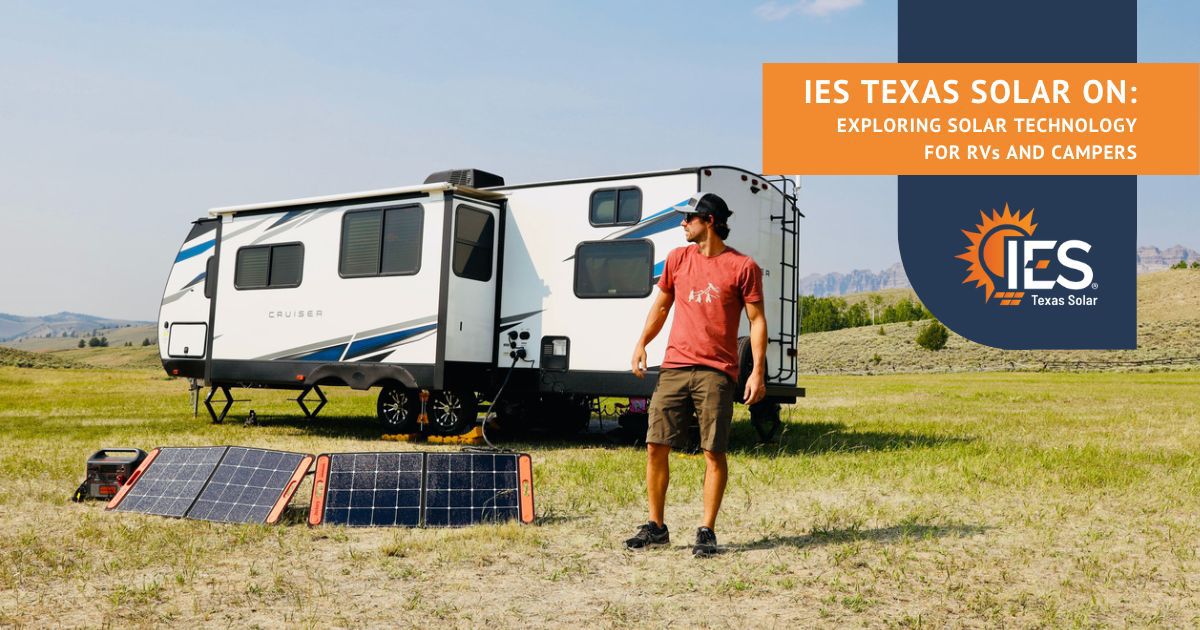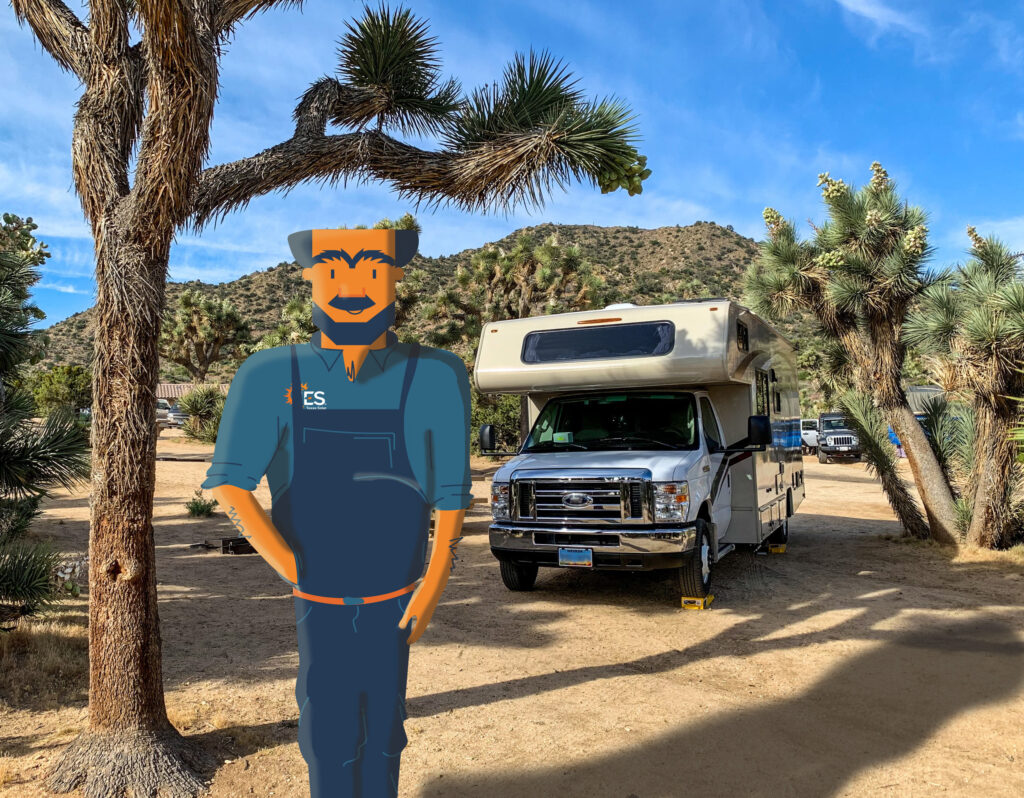
Time to read: 6 minutes
Date: December 13, 2022
Solar powered energy has become a popular cost-saving and reliable energy source for many uses. You can find solar powered technology on tiny homes in remote locations, sprawling agricultural operations and everything in-between across the country. But did you know that many are also taking advantage of the power of the sun while away from home?
Since the pandemic, more people are looking for ways to get out of the house and to travel and experience new adventures. One popular alternative to hotels and resorts is to take your own home away from home in the form of campers and RV’s. In fact, RV sales in the U.S. over the last two years have climbed by more than 15 percent. Some have even made the decision to live in their RV’s full time.
With the freedom to travel wherever you want, while bringing your beds, bathroom and a kitchen full of appliances with you, the only thing holding you back is how to power those appliances and any other energy needs you may have. If life is a highway for you, the answer may be solar power energy for your RV or Camper.
Many RV parks and campgrounds provide electrical hookups, known as “shore power,” but for those looking to get off the beaten path, where those hookups are unavailable, many are looking to solar power for the long haul. In addition, with electric RV’s and campers on the rise, buyers are finding that solar panels and also home charging stations are a must to maximize the potential of their new home away from home.
So how does it work?

An RV or camper solar power system generally includes the following components:
- Solar Panels
- A Charge Controller
- Solar batteries
- Inverter
- Proper wires and cables
- Racking and mounting equipment
With solar panels installed on the top of your RV, the cells of those panels are able to absorb energy from the sun while on the road or parked during the day. Within those solar panel cells, circuits turn the energy from the sun into electrical current, which then travels through wires to the solar charge controller controlling the current to solar battery/batteries. The batteries are charged by the DC (direct current) electricity and the energy is stored for later use to power your appliances and other devices within your RV.
The DC power from the solar panels is typically 12-volts; however, it can be passed through an inverter to convert to 120-volt AC (alternating current) to power devices such as your coffee pot or radio.
All of the components can be purchased separately, or there are RV solar panel kits that include most of the components needed.
Without solar panels, to use the 120-volt outlets scattered throughout the RV, you are at the mercy of shore power, which isn’t always available, or generator power, which requires fuel such as diesel or propane. But what if you are boondocking off the grid? Shore power or a nearby source to refill your diesel or propane may not be available and you might find yourself up the creek without a paddle.
What about high energy requirements like air conditioning?
Yes, you can power your RV air conditioner system as well as other appliances, but you need to know how much solar power is required to do this. There’s not a “one size fits all” equation for this and every camper or RV is different, but some simple math can give you a general idea of what you need to give you the energy independence you are looking for while on the road less traveled.

Let’s look at a scenario using our good friend Wattson. Wattson has an RV and is looking to find out how much solar he would need to run his air conditioner, watch TV, make coffee and heat his shower water without having to use shore power. A simple internet search for “RV Solar Energy Audit Calculator” allows Wattson to input all of the appliances he is looking to use and how many hours per day he would like to run them, to get an estimate of how much solar power is needed.
After completing the audit, Wattson finds his daily energy requirement is 8,500 watt hours (Wh), which includes a 10% addition to account for power lost through conversion.
To calculate the solar requirement, Wattson divides his Wh requirement by the amount of peak sunlight hours in a day. This varies depending on weather and location, but generally there are between three to six peak sunlight hours in a day in North America.
8,500Wh / 5 peak sunlight hours = 1700 Watts
With five hours of peak sunlight, Wattson would need 1700 watts of solar power; however, there is another consideration to include in his calculations.
Solar panels are rated and tested at a cell temperature of 77 degrees Fahrenheit; however, in reality if the ambient temperature is 77 degrees, the dark color of the panel along with the placement in direct sunlight means the panels are typically around 30 degrees hotter. So Wattson needs to add a 25% buffer to account for the solar array operating at 75% of its rated output during peak sunlight conditions.
1,700W + 25% = 2,125W
With a requirement of 2,125W of solar power, Watton needs to consider the roof size of his RV and whether or not he has the space available. If not, he can reprioritize his energy usage requirements or he can augment his rooftop solar system with deployable folding panels that can be placed on the ground, providing 400W-600W of additional solar power.
Of course since Wattson is a DIY kind of guy, he will be sure to consult with the panel manufacturer and operating manuals for his DIY system and suggests you should too to ensure everything is done correctly and safely. For home and business systems, leave the calculations to the solar consultants and engineers over at IES Texas Solar to help with your solar energy needs.
Other solar options for adventurers
If drilling holes in your RV roof and running wires is a final destination too far, then you could go the scenic route and consider portable solar options.
There are many options on the market for portable solar systems that you can fold up and take with you on the road. While these are often smaller than the rooftop options, they do have some added benefits.
On a hot day, you may be looking to park your RV in the shade. While this would potentially decrease rooftop panel efficiency, portable panels can be taken out and placed in direct sunlight. With charge controllers that can still connect directly to your RV batteries, these portable solar panels are another option for energy while on the road and off the grid.
Additionally, smaller campers and RVs may not have room for rooftop panels, but chances are that there is room under a bed or in a cabinet for a foldable solar panel. They are also cheaper, require little to no maintenance and if you upgrade or change RV’s your portable solar system can easily be moved.
Take the high road and switch to solar power for your RV or camper and when you get home call IES Texas Solar to start your solar journey for your home or business!
Many Texans explore solar energy on a smaller scale on mobile systems like portable generators and solar panels. After experiencing the technology at work in a bite size application, they progress into fully integrating it into their daily lives investing in solar energy systems, backup batteries, and home generators. While IES Texas Solar does not offer portable solar products and services, we can certainly assist with all of your home and business solar powered system needs!
If you are considering switching to solar for your home or business, reach out to us by going to our website, iestxsolar.com, or by giving us a call at (855) 447-6527.
Sources:
https://www.envirodesignproducts.com/blogs/news/why-is-the-rv-industry-gaining-popularity
https://battlebornbatte ries.com/rv-solar-panels-guide/
https://news.energy sage.com/rv-solar-panels/
https://rvsolar connections.com/rv-air-conditioner-with-solar/
https://www.greencarreports.com/news/1135862_fully-electric-rvs-range-charging-challenges-electric-cars